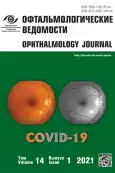Endpoints selection in registration clinical trials and the needs of real-world clinical practice with the example of anti-VEGF therapy in neovascular age-related macular degeneration
- Authors: Astakhov S.Y.1, Plavinskii S.L.2
-
Affiliations:
- I.P. Pavlov First Saint Petersburg State Medical University
- I.I. Mechnikov North-Western State Medical University
- Issue: Vol 14, No 1 (2021)
- Pages: 25-33
- Section: Original study articles
- URL: https://journals.rcsi.science/ov/article/view/63571
- DOI: https://doi.org/10.17816/OV63571
- ID: 63571
Cite item
Abstract
The issues of endpoints selection for regulatory requirements and real-world clinical practice using the example of anti-VEGF therapy in neovascular age-related macular degeneration (nAMD) are discussed in the article. New technologies (optical coherent tomography) introduction are shown to change clinical practice but not regulatory requirements on the endpoints. In the same time for regulatory purpose clinical trials design is changed from superiority to non-inferiority. The changes in the approach to primary endpoint selection are not anticipated due to regulator’s conservatism but there is a requirement to the comparison with best treatment alternative (i.e. same class comparator in case of anti-VEGF therapy) due to ethical reasons. To satisfy real-world clinicians need, the secondary endpoints are analyzed, but multiple testing problem appears. Statistical methods developed in recent years allow using specified comparison to be made without inflating Type I error. HAWK and HARRIER clinical trials demonstrated an example how superiority of brolucizumab over aflibercet on anatomical endpoints was reliably found.
Full Text
##article.viewOnOriginalSite##About the authors
Sergey Y. Astakhov
I.P. Pavlov First Saint Petersburg State Medical University
Author for correspondence.
Email: astakhov0761@mail.ru
ORCID iD: 0000-0003-0777-4861
SPIN-code: 7732-1150
Dr. Sci. (Med.), professor
Russian Federation, 6–8 L’va Tolstogo str., Saint Petersburg, 197022Svyatoslav L. Plavinskii
I.I. Mechnikov North-Western State Medical University
Email: s.plavinskij@szgmu.ru
ORCID iD: 0000-0001-9159-6177
SPIN-code: 5660-4661
MD, PhD, Dr. Sci (Med), professor
Russian Federation, Saint PetersburgReferences
- DiMasi JA, Grabowski HG, Hansen RW. Innovation in the pharmaceutical industry: New estimates of R&D costs. J Health Econ. 2016;47:20–33. doi: 10.1016/j.jhealeco.2016.01.012
- Arnold JJ, Markey CM, Kurstjens NP, Guymer RH. The role of sub-retinal fluid in determining treatment outcomes in patients with neovascular age-related macular degeneration — a phase IV randomised clinical trial with ranibizumab: the FLUID study. BMC Ophthalmol. 2016;16:31. doi: 10.1186/s12886-016-0207-3
- Schmidt-Erfurth U, Chong V, Loewenstein A, et al. Guidelines for the management of neovascular age-related macular degeneration by the European Society of Retina Specialists (EURETINA). Br J Ophthalmol. 2014;98(9):1144–1167. doi: 10.1136/bjophthalmol-2014–305702
- Wykoff CC, Clark WL, Nielsen JS, et al. Optimizing Anti-VEGF Treatment Outcomes for Patients with Neovascular Age-Related Macular Degeneration. J Manag Care Spec Pharm. 2018;24 (2-a Suppl): S3–S15. doi: 10.18553/jmcp.2018.24.2-a.s3
- Rosenfeld PJ, Puliafito CA, Michels S, et al. Systemic Bevacizumab (Avastin®) Therapy for Neovascular Age-Related Macular Degeneration (SANA) Study: Visual Acuity Outcomes. Invest. Ophthalmol. Vis. Sci. 2005;46(13):2310.
- Emerson MV, Lauer AK, Flaxel CJ, et al. Intravitreal bevacizumab (Avastin) treatment of neovascular age-related macular degeneration. Retina. 2007;27(4):439–444. doi: 10.1097/IAE.0b013e31804b3e15
- Rich RM, Rosenfeld PJ, Puliafito CA, et al. Short-term safety and efficacy of intravitreal bevacizumab (Avastin) for neovascular age-related macular degeneration. Retina. 2006;26(5):495–511. doi: 10.1097/01.iae.0000225766.75009.3a
- Rosenfeld PJ, Brown DM, Heier JS, et al. Ranibizumab for neovascular age-related macular degeneration. N Engl J Med. 2006;355(14):1419–1431. doi: 10.1056/NEJMoa054481
- Brown DM, Kaiser PK, Michels M, et al. Ranibizumab versus verteporfin for neovascular age-related macular degeneration. N Engl J Med. 2006;355(14):1432–1444. doi: 10.1056/NEJMoa062655
- Heier JS, Boyer DS, Ciulla TA, et al. Ranibizumab combined with verteporfin photodynamic therapy in neovascular age-related macular degeneration: year 1 results of the FOCUS Study. Arch Ophthalmol. 2006;124(11):1532–1542. doi: 10.1001/archopht.124.11.1532
- Takeda AL, Colquitt J, Clegg AJ, Jones J. Pegaptanib and ranibizumab for neovascular age-related macular degeneration: a systematic review. Br J Ophthalmol. 2007;91(9):1177–1182. doi: 10.1136/bjo.2007.118562
- Heier JS, Brown DM, Chong V, et al. Intravitreal aflibercept (VEGF trap-eye) in wet age-related macular degeneration. Ophthalmology. 2012;119(12):2537–2548. doi: 10.1016/j.ophtha.2012.09.006
- Mauri L, D’Agostino RB Sr. Challenges in the Design and Interpretation of Noninferiority Trials. N Engl J Med. 2017;377(14): 1357–1367. doi: 10.1056/NEJMra1510063
- Wickremasinghe SS, Janakan V, Sandhu SS, et al. Implication of recurrent or retained fluid on optical coherence tomography for visual acuity during active treatment of neovascular age-related macular degeneration with a treat and extend protocol. Retina. 2016;36(7):1331–1339. doi: 10.1097/IAE.0000000000000902
- Nguyen QD, Das A, Do DV, et al. Brolucizumab: Evolution through Preclinical and Clinical Studies and the Implications for the Management of Neovascular Age-Related Macular Degeneration. Ophthalmology. 2020;127(7):963–976. doi: 10.1016/j.ophtha.2019.12.031
- Dugel PU, Jaffe GJ, Sallstig P, et al. Brolucizumab Versus Aflibercept in Participants with Neovascular Age-Related Macular Degeneration: A Randomized Trial. Ophthalmology. 2017;124(9): 1296–1304. doi: 10.1016/j.ophtha.2017.03.057
- Cao J, Zhang S. Multiple comparison procedures. JAMA. 2014;312(5):543–544. doi: 10.1001/jama.2014.9440
- Dugel PU, Koh A, Ogura Y, et al. HAWK and HARRIER: Phase 3, Multicenter, Randomized, Double-Masked Trials of Brolucizumab for Neovascular Age-Related Macular Degeneration. Ophthalmology. 2020;127(1):72–84. doi: 10.1016/j.ophtha.2019.04.017
- Agostini H, Mulyukov Z, Tsilimbaris M, et al. Comparison of the Efficacy of Brolucizumab with Natural Disease Progression in Wet AMD Using Clinical Data from the Phase III HAWK and HARRIER Trials and Modelled Placebo Data. Curr Eye Res. 2020;45(10): 1298–1301. doi: 10.1080/02713683.2020.1731832
- Ho AC, Busbee BG, Regillo CD, et al. Twenty-four-month efficacy and safety of 0.5 mg or 2.0 mg ranibizumab in patients with subfoveal neovascular age-related macular degeneration. Ophthalmology. 2014;121(11):2181–2192. doi: 10.1016/j.ophtha.2014.05.009
- Yadav K, Lewis RJ. Gatekeeping Strategies for Avoiding False-Positive Results in Clinical Trials With Many Comparisons. JAMA. 2017;318(14):1385–1386. doi: 10.1001/jama.2017.13276
- Kertes PJ, Galic IJ, Greve M, et al. Canadian Treat-and-Extend Analysis Trial with Ranibizumab in Patients with Neovascular Age-Related Macular Disease: One-Year Results of the Randomized Canadian Treat-and-Extend Analysis Trial with Ranibizumab Study. Ophthalmology. 2019;126(6):841–848. doi: 10.1016/j.ophtha.2019.01.013
- Ross AH, Downey L, Devonport H, et al. Recommendations by a UK expert panel on an aflibercept treat-and-extend pathway for the treatment of neovascular age-related macular degeneration. Eye (Lond). 2020;34(10):1825–1834. doi: 10.1038/s41433-019-0747-x
- Dugel PU, Singh RP, Koh A, et al. HAWK and HARRIER: Ninety-Six-Week Outcomes from the Phase 3 Trials of Brolucizumab for Neovascular Age-Related Macular Degeneration. Ophthalmology. 2021;128(1):89–99. doi: 10.1016/j.ophtha.2020.06.028
Supplementary files







